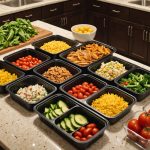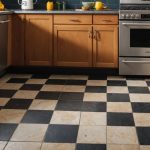Choosing the right bread proofing basket can make all the difference in your baking journey. A suitable basket prevents sticky dough and ensures optimal shape and texture for your loaves. Understanding the variety of materials, shapes, and sizes available empowers you to make an informed decision. This guide highlights essential factors to consider, helping you select the perfect basket for your sourdough or artisan breads, while avoiding common pitfalls. Unlock the secrets to achieving flawless, non-sticky dough with the ideal proofing basket tailored to your needs.
Overview of Bread Proofing Baskets
Bread proofing baskets, also known as bannetons, play a crucial role in the bread-making process. They provide structure and shape to the dough during its final rise. Understanding the different types of bread proofing baskets is essential for achieving the perfect loaf.
Additional reading : Unlocking Space: Smart Strategies to Maximize Storage in Your Cozy Kitchen
Types of Bread Proofing Baskets
Banneton baskets are traditionally made from rattan and are popular for their ability to wick moisture away from the dough, resulting in a crispy crust. They are known for their spiral pattern, which imprints beautifully on the bread.
Other materials, such as silicone, are also used for proofing baskets. Silicone baskets are non-stick and easy to clean, making them a convenient option for home bakers. However, they may not provide the same moisture-wicking properties as rattan.
Also read : Your Ultimate Guide to Selecting a Versatile Fish Poacher for Varied Fish Sizes
Choosing the Right Basket
Selecting the appropriate bread proofing basket depends on the dough type and desired crust. For wetter doughs, a rattan banneton is ideal due to its moisture-absorbing qualities. Meanwhile, silicone baskets are suitable for those who prioritize ease of cleaning. Understanding these differences ensures the best results for various bread recipes.
Materials Used in Bread Proofing Baskets
Understanding the proofing basket materials is vital for bakers aiming to perfect their craft. The choice of material can significantly influence the dough's behaviour and the bread's final texture.
Common Materials and Their Characteristics
-
Rattan: Known for its moisture-wicking properties, rattan is the classic choice. It helps create a crispy crust and leaves a distinctive spiral pattern on the dough.
-
Bamboo: Similar to rattan, bamboo is lightweight and offers good moisture absorption. It's a sustainable option and often praised for its durability.
-
Plastic: Plastic baskets are easy to clean and maintain. However, they lack the moisture-wicking properties of natural materials, which can affect the crust's crispness.
- Ceramic: Ceramic baskets are sturdy and can retain heat well, aiding in even dough rising. They are heavier and more fragile than other materials.
Pros and Cons
-
Dough Sticking: Natural materials like rattan and bamboo may require dusting with flour to prevent sticking. Plastic and ceramic are typically non-stick but may not enhance the crust texture.
-
Final Bread Texture: Rattan and bamboo contribute to a superior crust, while plastic and ceramic provide convenience and easy maintenance.
Key Factors to Consider When Selecting a Proofing Basket
Choosing the right proofing basket is essential for bakers aiming to perfect their bread. Several key factors should guide your selection process.
Size and Shape Considerations
The size and shape of the basket significantly influence the final appearance of your bread. For instance, if you’re baking a traditional round loaf, a round basket is ideal. Conversely, for baguettes or oval loaves, an elongated basket is more suitable. The basket should accommodate the dough comfortably, allowing for even expansion without overflow.
Basket Depth and Design
The depth and design of the basket are crucial for proper dough expansion. A deeper basket supports taller loaves, while shallower designs are better for flatter breads. The basket's design, whether spiral or smooth, can also imprint patterns on the bread, adding an aesthetic touch.
Cost Versus Quality
Balancing cost and quality is important when selecting a proofing basket. Higher-quality materials like rattan or bamboo may come at a premium but offer superior moisture-wicking properties and durability. Cheaper materials like plastic might save money upfront but could compromise the bread's crust quality and overall texture. Prioritising quality often results in better baking outcomes.
Tips to Prevent Sticky Dough
Dealing with sticky dough can be frustrating for bakers, but several strategies can help mitigate this issue. Choosing the right flour is paramount. Opt for flours with higher protein content, such as bread flour, which can help develop a stronger gluten network, reducing stickiness. Additionally, incorporating whole wheat or rye flour can enhance the dough's structure.
Proper maintenance of your proofing basket is also crucial. After each use, ensure the basket is thoroughly cleaned and dried to prevent moisture build-up, which can contribute to sticking. Regularly dusting the basket with flour, particularly rice flour, is highly effective. Rice flour is less absorbent than wheat flour, providing a non-stick surface that helps the dough release easily.
Before placing the dough, prepare the basket by generously dusting it with flour. Alternatively, use a cloth liner, which can be floured and placed inside the basket to further prevent sticking. This technique not only aids in easy removal but also preserves the basket's condition. By implementing these practices, bakers can achieve a seamless proofing process and produce beautifully shaped loaves.
Product Recommendations and Comparisons
Choosing the best bread proofing baskets can significantly impact your bread-making experience. Popular options on the market include rattan, bamboo, and silicone baskets, each offering unique features.
Reviews of Popular Proofing Baskets
Rattan baskets are highly praised for their durability and ability to create a crispy crust. Users often highlight their moisture-wicking properties, which enhance the dough's texture. Bamboo baskets share similar qualities, with the added benefit of being a sustainable choice. Silicone baskets, on the other hand, are favoured for their non-stick surface and ease of cleaning, although they may not provide the same crust quality.
Comparison of Features
When comparing features, consider price, durability, and performance. Rattan and bamboo baskets may come at a higher cost but offer superior performance and longevity. Silicone baskets are more affordable and convenient but might compromise on crust quality.
User Testimonials and Experiences
User experiences vary, with many bakers appreciating the traditional feel of rattan and bamboo. Testimonials often mention the beautiful patterns these baskets imprint on the dough. Meanwhile, those prioritizing convenience often prefer silicone for its easy maintenance. Ultimately, the best choice depends on your baking priorities and preferences.
Visual Guide to Bread Proofing Baskets
A bread proofing basket is an essential tool in bread-making, offering both functionality and artistry. This visual guide provides a comprehensive look at how different materials and preparations impact your baking results.
Infographic: Basket Types and Benefits
An infographic can be a handy reference, summarising the types of baskets and their benefits. For example, rattan baskets are praised for their moisture-wicking properties, enhancing the dough's texture and crust. Bamboo baskets, being lightweight and durable, offer similar advantages. Meanwhile, silicone baskets are valued for their non-stick surface and ease of cleaning.
Side-by-Side Images: Material Effects on Dough
Images showcasing the effects of different materials on dough can be enlightening. For instance, observe how a rattan basket leaves a beautiful spiral imprint, while a silicone basket maintains a smooth surface. These visual comparisons help bakers understand how material choice influences the final loaf.
Step-by-Step Images: Preparing a Basket
Step-by-step images guide bakers on how to prepare a proofing basket effectively. Start by dusting the basket with flour, ensuring even coverage. This process prevents sticking and preserves the basket's condition. Such visuals offer clarity, making it easier for bakers to follow and achieve consistent results.











